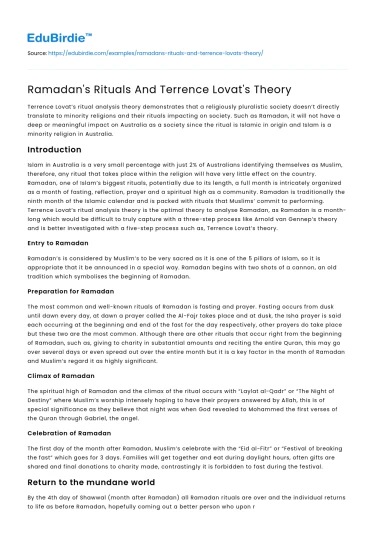Terrence Lovat’s ritual analysis theory demonstrates that a religiously pluralistic society doesn’t directly translate to minority religions and their rituals impacting on society. Such as Ramadan, it will not have a deep or meaningful impact on Australia as a society since the ritual is Islamic in origin and Islam is a minority religion in Australia.
Introduction
Islam in Australia is a very small percentage with just 2% of Australians identifying themselves as Muslim, therefore, any ritual that takes place within the religion will have very little effect on the country. Ramadan, one of Islam’s biggest rituals, potentially due to its length, a full month is intricately organized as a month of fasting, reflection, prayer and a spiritual high as a community. Ramadan is traditionally the ninth month of the Islamic calendar and is packed with rituals that Muslims’ commit to performing. Terrence Lovat’s ritual analysis theory is the optimal theory to analyse Ramadan, as Ramadan is a month-long which would be difficult to truly capture with a three-step process like Arnold van Gennep’s theory and is better investigated with a five-step process such as, Terrence Lovat’s theory.
Save your time!
We can take care of your essay
- Proper editing and formatting
- Free revision, title page, and bibliography
- Flexible prices and money-back guarantee
Entry to Ramadan
Ramadan’s is considered by Muslim’s to be very sacred as it is one of the 5 pillars of Islam, so it is appropriate that it be announced in a special way. Ramadan begins with two shots of a cannon, an old tradition which symbolises the beginning of Ramadan.
Preparation for Ramadan
The most common and well-known rituals of Ramadan is fasting and prayer. Fasting occurs from dusk until dawn every day, at dawn a prayer called the Al-Fajr takes place and at dusk, the Isha prayer is said each occurring at the beginning and end of the fast for the day respectively, other prayers do take place but these two are the most common. Although there are other rituals that occur right from the beginning of Ramadan, such as, giving to charity in substantial amounts and reciting the entire Quran, this may go over several days or even spread out over the entire month but it is a key factor in the month of Ramadan and Muslim’s regard it as highly significant.
Climax of Ramadan
The spiritual high of Ramadan and the climax of the ritual occurs with “Laylat al-Qadr” or “The Night of Destiny” where Muslim’s worship intensely hoping to have their prayers answered by Allah, this is of special significance as they believe that night was when God revealed to Mohammed the first verses of the Quran through Gabriel, the angel.
Celebration of Ramadan
The first day of the month after Ramadan, Muslim’s celebrate with the “Eid al-Fitr” or “Festival of breaking the fast” which goes for 3 days. Families will get together and eat during daylight hours, often gifts are shared and final donations to charity made, contrastingly it is forbidden to fast during the festival.
Return to the mundane world
By the 4th day of Shawwal (month after Ramadan) all Ramadan rituals are over and the individual returns to life as before Ramadan, hopefully coming out a better person who upon reflection and fasting during the month has bettered themselves. Otherwise it is simply a month of going through the motions and ticking boxes to continue pretending to have a relationship with their God, Allah.






 Stuck on your essay?
Stuck on your essay?

